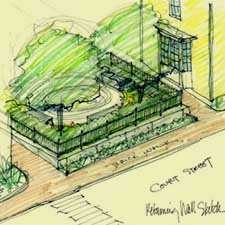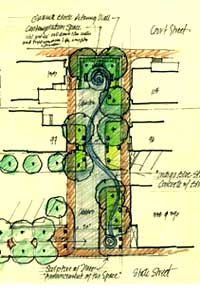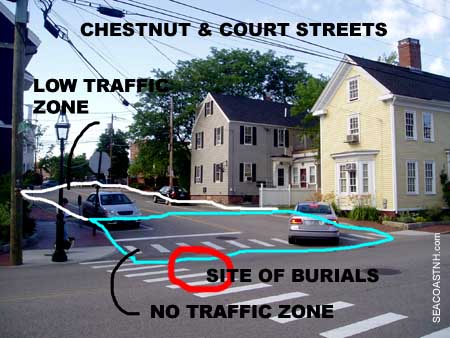| Portsmouth African Burial Ground Blues |

When workmen "discovered" the African American Burial Ground beneath the streets of Portsmouth in 2003, the city agreed with one voice that a memorial was needed. But how to honor as many as 200 citizens whose graves had been ignored and built over by the city? The first draft of the memorial designs were released recently, and in the words of the Burial Ground committee chairman, "Now we know what we don’t want."
EDITORIAL: Black Cemetery Memorial Still in Limbo
READERS RESPOND to this editorial
VISIT OUR: Black Heritage web section
I haven’t written about the African Burial Ground project for years. I find the topic too emotional to cover. It still shames and enrages me that, in a city with acres and acres of cemeteries, Portsmouth managed to tar and build over its one graveyard delegated to black citizens. When I talk about this topic, my voice cracks. We did to these poor souls in death, what we did to them in life. We denied them their humanity.
 When a few of what may be hundreds of decayed coffins were discovered under the street at the corner of Court and Chestnut in the fall of 2003, it was no surprise. A bronze Black Heritage Trail plaque at the top of the street told us what was buried there. People have been working hard for generations not to dig too deep and uncover what everyone knew was under the street. It was no surprise, but it was a great relief. Portsmouth’s long-whispered secret was finally exposed. The time for apologies, reparations and forgiveness had begun.
When a few of what may be hundreds of decayed coffins were discovered under the street at the corner of Court and Chestnut in the fall of 2003, it was no surprise. A bronze Black Heritage Trail plaque at the top of the street told us what was buried there. People have been working hard for generations not to dig too deep and uncover what everyone knew was under the street. It was no surprise, but it was a great relief. Portsmouth’s long-whispered secret was finally exposed. The time for apologies, reparations and forgiveness had begun.
Last month, after years of research, discussion and planning, the City of Portsmouth unveiled the first draft of its design for a memorial area on Chestnut Street. The design did not carry water. It was unremarkable. It looked, for lack of a better description, like a white-man’s park, with neatly placed signs, concrete benches, pretty shrubs, brick walkways, a fence and a little memorial. It looked safe. It looked cost-effective. It looked like every tiny memorial park you have ever seen. The most interesting concept showed a serpentine pathway that, at second glance, looked almost exactly like the logo of Woodman & Company Landscape Architecture, LLC, the firm that submitted the designs.
Pretty much everyone in attendance at the last African Burial committee meeting was disappointed. But this is a very polite group and no one got upset. Historian Valerie Cunningham calmly explained, once again, the difference between traditional white cemetery design and the African way of death. Africans saw all members of their community as one big family and bodies were often buried close together with little if any permanent markings. Committee members suggested that the site might be colorful, less perfect and neat, more reflective of African imagery and African beliefs. The design firm accepted the criticism graciously and headed back to the drawing board. What we have so far is the musical equivalent of Gerry and the Pacemakers singing their bland version of a dynamic Little Richard tune. What the project needs now – has needed from the start – is a visionary artist who can turn this emotional story into a powerful public space.
CONTINUE
AFRICAN CEMETERY MEMORIAL continued

I wish I was that artist. I have all of the necessary emotion, but none of the requisite skill or experience. Today I took the city’s sketches over to Chestnut Street and tried to "see" the memorial as it will look years from now. It is a hard assignment. Our planned homage to centuries of neglect will only close off a tiny portion of a largely-untraveled side road connecting the busy Court and State streets. It is not a significant sacrifice when compared to the event being memorialized, so the memorial itself must speak loudly and clearly.
The design divides Chestnut into three zones. At the State Street end, traffic will continue to flow in and out of an apartment house parking lot and a drive-up bank building. The second zone will be limited to the traffic from three driveways. The third zone blocks off the end of Chestnut where it meets Court Street. This is the heart of the memorial, a space about the width of a house and smaller than my little back yard. Much of the African Burial Ground with its anonymous dead, therefore, remains under the streets where traffic flows freely.
What I see, no matter how I try to look away, is a massive black hand and arm erupting from the broken asphalt. The hand is worn and deeply lined. It reaches at an angle toward the sky. The hand is half-open, fingers half curled in a gesture that is both gentle and strong. This is a figure in the act of breaking free, but a figure still unknown and unseen, invisible beneath the pavement. It is any figure, from the past or modern times, anyone who has been enslaved by powerful forces and refuses to remain there. Maybe the hand is carved from wood or stone. I’m no artist, it’s just what I see.
Others have suggested trees. I like the feeling in that concept. I’m intrigued by the idea of turning Chestnut Street back into the wooded area it was when the city fathers set it at arm’s length as a burial place for Africans and paupers. How great would it be to make a forest out of a street, with green plants rooted in the rich dark past and disrupting the predictable cityscape? Someone noted in an earlier planning meeting that trees presented a problem since their roots would disrupt the graves, as if cellar holes and sewer pipes and water mains did not do that already. Maybe the trees are not made of wood. Maybe they are decorated in colorful imagery. I don’t know. I was weaned on Gerry and the Pacemakers and my favorite color is beige. I’m not African American and I’m no artist. But I don’t believe we honor the long-forgotten dead by creating a space that attracts no attention.
Councilman John Hynes, who chairs the African Burial Ground Committee ended the last meeting hopefully. Now that we know what we don’t want, he said, we are one step closer to finding an answer. Hynes re-emphasized that the memorial is, on one level, an apology, and on another, a promise from the city that it will never treat its citizens so horribly again. By working together, Hynes concluded, we will create a space that pleases everyone. On this point, I told him after the meeting, I had to disagree.
I hate to think we are building a space, small as it is, that has to please the public. Pleasing the public is what got us into this mess in the first place when our ancestors quietly turned the Negro Burying Ground into a commercial development, then pretended the cemetery had never existed. Pleasing the public gets us concrete benches and shrubs and water features. It gets us guys on horses and men holding rifles and neat little tombstones all in a row. If this is the 18th century African Burying Ground, then it should tell us a story we don’t already know about people we almost forgot. I want to hear one colorful voice singing out among a chorus of white faces. I don’t want something safe and comfortable here. I have lived all my life among people who look like me, so I cannot imagine the life these invisible citizens endured, but I want to learn about it now. Please tell me, Portsmouth, about the people beneath the road. Years from now, when this process is done, I hope to walk down Chestnut Street and discover a world I’ve never known.
Copyright © 2007 by J. Dennis Robinson. All rights reserved.
OUTSIDE LINK City of Portsmouth burial ground design
CONTINUE
AFRICAN CEMETERY MEMORIAL continued
OUR READERS RESPOND TO THIS ARTICLE
MORE AFRICAN BURIAL GROUNDS
Hurrah, Dennis! Thanks for expressing for us unemotive whitefolks the feelings implicit in this forgotten intersection of graves and roads and history and peoples. We need your voice to touch our ears and hearts, as well as the voices of Valerie Cunningham and other members of the local African-American community. We're all in a learning process, and with the guidance of artistic insight a site worthy of these unremembered lives can lead us towards healing.
Jennifer Stiefel
What a great, affecting essay on the African burial ground memorial. I was close to tears...usually am when that's mentioned. Somehow, it would be helpful if the design drew in the curious, beguiling them with a bit of nice and then shocked them with the truth when they reached the Court Street end. Please keep on keeping on. You're SO needed.
Pat Wall.
AFRICAN BURYING GROUND
To the Editor of the NH Gazette: I agree with J. Dennis Robinson that the memorial should honor those buried below while actively engaging our minds, as opposed to a memorial that invites one to sit on their behind. The hand emerging from the earth idea is a good one. I recently had a conversation with a Zulu African about their round huts, these buildings are spiritual places where people go to seek guidance from their ancestors, only elders are allowed to sleep there and children to keep the elders company. I would love to see a small hut, and a tree in the park surrounded by a discriminating round fence that only lets children in (the elders are already there). They can go into the hut and inscribed on the wall are the names of the African tribes that helped found this country. Let¹s provoke the children, the promise of our future, to discuss.
Didi Wallace, Portsmouth, NH
